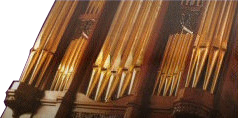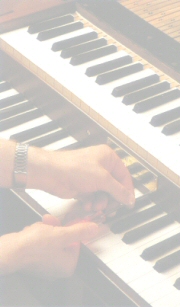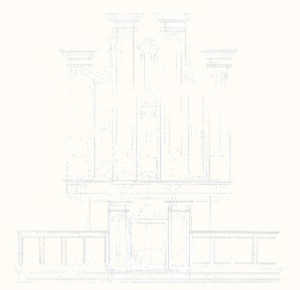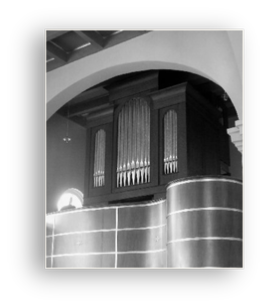*) Additions with pipework from stock; the pipework of the Open Diapason 8 ft (Pedal) has not yet been placed.
Great to Swell, Great to Pedal, Swell to Pedal
History
The order book (in possession of the still existing company Walker),
mentions that this instrument was built in 1844 for William Cubitt,
Bedford Hill House, Balham Hill, "without a Case". William Cubitt was
in 1861 Lord Major of London, and from 1847 to 1861 MP for Andover.
Both manuals got the old English compass from contra-G, where Swell started at tenor-c. The pedal got its already modern compass from great C, with a chest on which 15 open wooden pipes were placed (CC-d). Curious is the mention in the order book that from the lbottom octave of the Swell-manual also the Pedal Open 16 ft could be played. The function of the contra-G keys of the Swell manual remains unclear.
After Cubitt's death the instrument moved to Balham Chapel (near London). On that occasion the pedal chest was extended to 25 notes (CC-c1), and the Swell was provided with a bass chest with 12 Stops Diapason pipes. The work is attributed to Bevington.
In 1943 a new move followed, performed by Kingsgate Davidson, to Baptist Church, Harston (near Cambridge). The anals mention that the instrument came from a church in London damaged by bombs. Possibly this was Balham Chapel. In 1998 the instrument was purchased by us. On this occasion the non-original front was left behind in the church.
The Ev.-ref. Kirche in Jemgum got in 1769 its current form as a cruciform church. In 1930 this church was destroyed by fire. In the same year the church was rebuilt by the architect Ludwig Deichgraber (1894-1969) in the then modern style of Art Deco. In 2004 the church was again hit by a fierce fire, which destroyed the entire roof and a large part of the interior. The Becker organ (1972) was also lost. The church was restored again, with the interior from the thirties being reconstructed.
The Walker organ in front of the church of Jemgum was fitted with a new oak case. The neglected instrument was fully restored and reconstructed. The Great was extended with a Twelfth 2 ²/3 ft and a Trumpet 8 ft. The Swell was extended with a Double Diapason 16 ft and was given a new bass chest with 17 cancels (contra G - b). The 8- and 4-foot labials speak from contra-G and the other voices from major-C, while the reeds have a common great octave.
The Pedal received a Bourdon 16 ft (for which the old Open Wood was partly used), a Trombone 16 ft, and a preparation for an Open Diapason 8 ft. A new chest was made. For the lost pipes of the Sesquialtra (Great), and for the extensions (Twelfth, Trumpet and Trombone) very well fitting pipes could be bought. The scales of the Sesquialtra could be found in some preserved pipes that were placed as highest tones in the treble of the reeds on the Swell. They all turned out to be a semitone smaller than the Sesquialtra of the Swell. The front pipes are new, and now complement the Open Diapason (from C-Fis), which originally only became independent on G. Also the largest pipes of the Principal are in the front.
Consultant for the restoration was Winfried Dahlke, who also performed in a concert on 13 December 2007. For the lost pipes of the Sesquialtra (Great), and for the extensions (Twelfth, Trumpet and Trombone) very well fitting pipes could be bought. The man-hours of the Sesquialtra could be found in some preserved pipes that were placed as highest tones in the treble of the reeds on the Swell. They all turned out to be a semitone scarier than the Sesquialtra of Swell. The front pipes are new, and now complement the Open Diapason (from C-Fis), which originally only became independent on G. Also the largest pipes of the Principal are in the front.





 Contact
Recordings
Previous page
Contact
Recordings
Previous page





 Previous page
Previous page




 Back to top
Back to top

